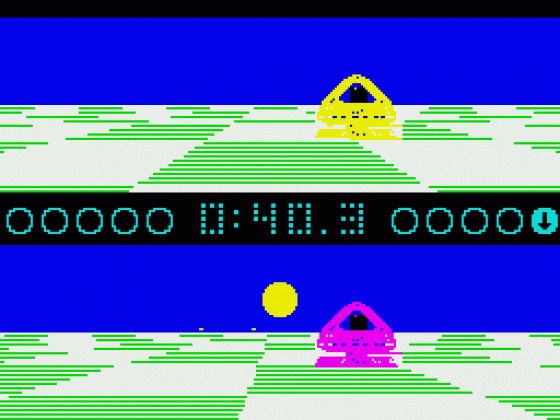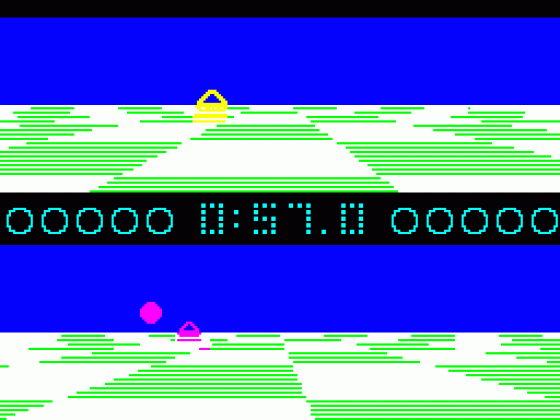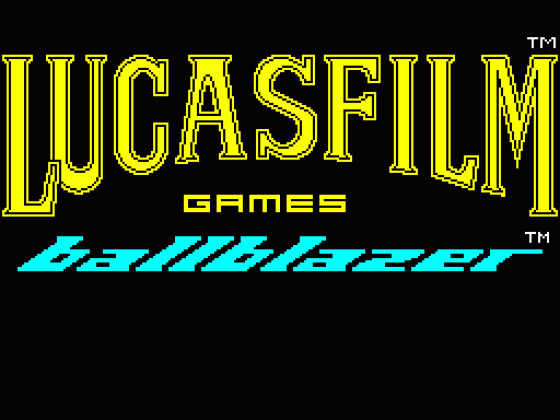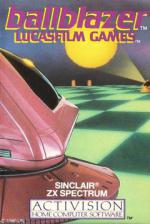
Sinclair User
 11th April 1986
11th April 1986
Author: Jerry Muir
Publisher: Activision
Machine: Spectrum 48K/128K
Published in Sinclair User #51
Ballblazer
Welcome, fans, to the 3097 Ballblazer championships and... hang on, am I the Sport Correspondent or not?
After Summer and Winter Games is seems the latest craze is Future Games. Only last month I was playing psychotic squash in the shape of Bounces. Now it's Ballblazer and... well, wait and see.
Lucasfilm Games insisted on the highest standards when it came to this conversion of an Atari classic. Was their perfectionism misguided? Ballblazer's closest contemporary is probably ice hockey, though it's played between two people, or droids, sitting in high velocity skimmers called Rotofoils.

The game has you blasting round a curved pitch which enforces an artificially close horizon, in search of the Plasmorb which hovers at head height and has to be blasted between two Goalbeams of pure energy.
As you might expect there's a lot of hi-tech jargon surrounding the game - everything apart from the 3097 equivalent of 'sick as a parrot, Ron' - so the best thing is to sit back and watch a sample game. Problem is that just pressing 'N', as suggested in the instructions, doesn't work. But fear not - the answer's quite simple, just use the selection system, which it must be admitted is a little clumsy at first, and set one droid against another then press 'S' to start. A word of warning though - Ballblazer make them both low Grade I droids if you want to follow the action. For mere spectator thrills though, set two Droid 9s against each other - they are fast.
Don't set yourself too high a challenge at first but go for a Droid 1, unless you're leaping straight in to play a human opponent, and swot up on a few tactics.

Seated in your pyramidal Rotofoil you have a split view - one for each opponent. It's the ideal way to cope with a two-player game and even against the computer could give you a chance to guess what the enemy has in mind - if you can snatch a second to look away from your own screen. Controls are simple, merely directions and fire, so with a not-too-taxing three minute bout chosen (nine, the maximum, would exhaust most mortal beginners) it's time for the kick off.
The rules of Ballblazer, possession and goal scoring, are easy - play isn't! You'll see the orb come shooting into the centre of your viewscreen but if you're not quick off the mark that may be your last time for a while. Race forward and at this level you'll probably take it. As the forcefield surrounding your foil captures it, the ball turns to your game colour. Don't dawdle for too long though - your opponent will already be gunning for you.
The foil snaps to face the direction of the goal-end, which is useful because the close horizon stops you seeing it immediately. Thrust in that direction. As you swerve the orb sways in front of you and this can be used to blast the ball off at an angle. At 60 metres, which is 16 squares on the checkerboard pitch, the goals suddenly come into view. Don't fire till you see the white of the posts but remember, the further back you are, the more you score. The price for success is one to three points but also a smaller goal next time.

Suddenly the orb will be snatched away from you and looking down you'll find that once again it's changed colour and is bobbing along in front of your opponent. Your best tackle is probably to swoop down trying to intercept from the side then giving a burst from your blaster to knock the ball free. If you're quick you should be able to recapture it. but for how long?
The other defence is blocking which includes acting as goalkeeper but it's an uncertain last resort and it's best to keep the other player away from the beams.
The winner is, not surprisingly, the highest scorer at full time, though it's a walkover - or 'shut out' - if one player scores all ten points. The most excitement I had was in a well balanced match (no, I won't say which level of Droid, other than it wasn't 9!) where we drew.

In this situation the game continues, the first to score again being the winner. We thrashed it out for a further five minutes at least - it seemed like five hours - until, after several near misses which I thought had cost me the game, I slammed it home. I almost did a lap of honour round the room, it was such a kick.
With other advanced techniques to learn such as dribbling and well judged skill levels this holds up very well as a game. There's a robotic sounding theme which could quickly become annoying but it can be switched off. Other than that the sound is mainly for information, such as the countdown beeps during the last seconds or the change in buzzing as you near an opponent ready to blast the orb away.
Graphically it's simple and, though there are odd attribute problems at times, the whole thing moves so fast through the two widescreen windows that it doesn't matter.
In fact it's all so fast that any visual shortcomings seem purely incidental. What really matters is that it is extremely addictive and immensely playable. Possibly the best, most convincing sport simulation on the market, even if there's nothing real to simulate.
Jerry Muir
Publisher: Activision Programmer: Lucasfilm Games Price: £9.95 Memory: 48K Joystick: Kempston, cursor, Interface II
*****













